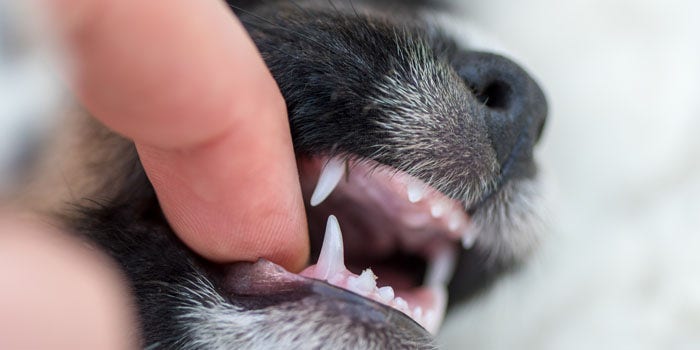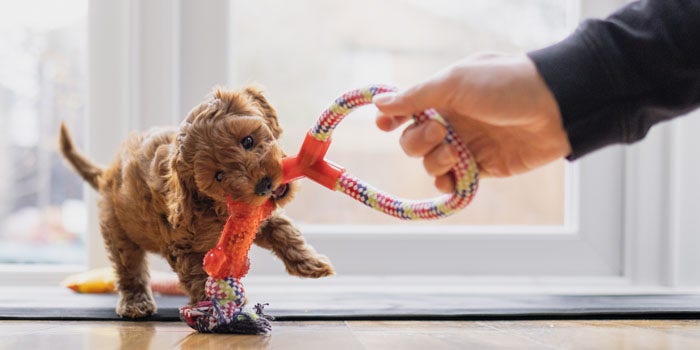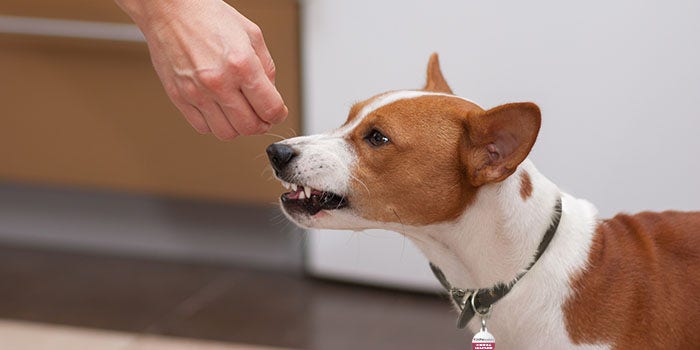
How to stop a dog from nipping
Tonya Wilhelm
Whether it’s mouthing, play-biting, or nipping, if your dog is demonstrating unwelcome biting behaviors, that’s one problem pet parents need to nip (pun intended) in the bud.
While mouthing and chewing are common in puppies, that doesn’t mean you should allow activity that’s too rough to go unchecked. Dogs who aren’t given proper direction and outlets for chewing as puppies may develop unwanted biting and nipping problems as they grow. Over 3 million dogs enter the shelter system each year, with behavioral issues like biting and nipping listed as the most common reason for surrender.
Taking a proactive approach during the first two years of a dog’s life can help you prevent such problems. To guide you through this challenging process, follow our steps to minimize biting and nipping, teach a dog to be gentle, and find professional support online and in person.

Why do dogs nip?
Puppy nipping is typically non-aggressive. It’s simply the way most puppies explore and learn about their environment. However, pay close attention to changes in this behavior, including an increase in frequency or intensity. Sometimes this indicates your puppy’s innocent nipping is evolving into inappropriate biting.
Not only are puppies learning about their world through nipping and chewing, but the activity can also teach them crucial lessons about interacting with others. For example, puppy play often involves a lot of wrestling, nipping, and even biting. Typically, when one puppy bites another too hard, the other pup will yelp and stop playing. Over time, that negative consequence teaches the biter how hard or soft to bite down and what’s not acceptable. This is called bite inhibition, and it’s a critical milestone in teaching dogs how to behave.
When is nipping a problem?
To teach your puppy what’s appropriate, it’s essential to recognize the difference between normal puppy mouthing or nipping and a more serious behavioral concern.
Regular puppy activity consists of mouthing, biting, and nipping during periods of play and overexcitement. However, if you find that your puppy nips at you at other times, such as when you reach for their food bowl or try to pet them when they’re resting, that’s not an appropriate response.
Your pet’s mood when nipping is another warning sign to recognize. Is your puppy acting silly and goofy, or do they seem angry and frustrated? Admittedly, puppies can sometimes be hard to read. Consult a dog trainer if you’re concerned about your puppy’s conduct. They may ask you to shoot a short video to understand your pet and potential needs better. It’s always easier to correct these behaviors when you notice them early rather than fix them later.
Is puppy play-biting OK?
The short answer is yes and no. Your puppy should learn bite inhibition through interacting with other dogs and puppies. It helps them to learn bite intensity without you sacrificing your fingers for the lesson. Attending a puppy class is a great way to encourage healthy, safe, age-appropriate play habits. Plus, your puppy gets to socialize with other puppies, and you get help and advice from a good dog trainer.
In cases where attending puppy classes or setting puppy play dates isn’t possible, consider teaching your puppy about bite inhibition yourself. Here’s how: Whenever you’re playing with your puppy, if they start to chew on you, continue the play as long as your puppy’s nips remain gentle. However, when the biting becomes aggressive, give a sharp yelp, remove your hand, and stop playing. Take a moment or two for your puppy to settle down. You can resume playing once they are calm. But be sure to halt any time the play or biting gets too rough.
For puppies who aren’t receiving the message, redirect them to a more appropriate chewing outlet. These should always be designated chew toys, not household objects like old shoes or blankets. These can confuse puppies because they blur the lines between what’s acceptable and what’s not.

Tips on how to stop a dog from nipping with behavior modification
The first step in teaching your puppy not to nip is to adjust your expectations. Puppies will nip; it’s what they are born to do. Your goal isn’t to teach your puppy not to nip, but to teach them when it’s appropriate.
Here are some tried-and-true techniques that can help those lessons stick!
Engage your dog
You’ve probably heard the phrase, “A tired dog is a good dog.” That’s especially true for curious and energetic puppies. The more you distract your puppy with mental and physical stimulation, the less time they have to engage in unwelcome nipping or biting.
If you notice your dog getting increasingly mouthier, take that as a sign it’s time for a change of pace or scenery — anything to keep your puppy’s mind off chewing.
Consider a trip to the park, going to the pet store, an impromptu puppy play date, a game of fetch, sniffy walks, or training exercises. The list is endless. Not only does this one-on-one time give you and your pup a chance to bond, but it can also tucker them out, so they’re not chewing or mouthing out of boredom.
Redirect your dog
The best way to help your puppy productively exercise their natural chewing instincts is to provide plenty of approved chewing alternatives. Stock up on an array of engaging puppy toys and chews and keep them close at hand — in every room, your pocket, the car, your bag — so you can instantly redirect your dog as needed.
The easier it is for you or your dog to grab a toy when the urge to nip, bite, or chew strikes, the faster they will learn what’s OK to chew and what’s not. Helping your dog make the right choice is always better than correcting them after they’ve made the wrong choice.
When you give your puppy the chew toy, try to remain as calm as possible, so they don’t get overexcited. Of course, you want them to have fun, but overstimulation can weaken your dog’s self-control.
Ensure that the toys you supply are big enough, so there’s no risk of your puppy nipping you while you’re playing with the toy together. There should be plenty of room for you to hold one end while your dog mouths the other.
As always, if the play is going well, praise your dog in a calm, happy voice. If your dog’s mouth moves up the toy or hits your hand, yelp and drop the toy. Ignore them for a moment or two, then resume playing when they’re settled. You are teaching them that play happens when they keep their mouth on the toy but stop once they put their mouth on you.
Reinforce independent play
Most puppies would rather play with you than a toy. So, you may need to reinforce the appeal of chew toys by rewarding your dog for independent play.
When you are all done playing, tell your puppy, “All done!” Then encourage your dog to settle down in a safe space like their crate with an approved chew toy or puzzle toy that’s filled with tasty treats. This helps signal that playtime with you has ended and that it’s fun and rewarding to play on their own, too.
Dog nipping warning signs
Nipping in adult dogs is a much harder habit to break, which is why it’s essential to start discouraging this activity when they’re young. Adult dogs that begin to bite or snap at others suddenly could also be reacting to pain or other health issues, so a visit to the veterinarian may be in order.
For both puppies and adult dogs, definite red flags exist, indicating a potential problem with biting. These include a dog who nips, bites, or growls when:
● you wake them up
● they’re eating
● they encounter strangers
● they’re angry or frustrated
When you see these warning signs, it’s time to work with a professional who can evaluate your dog and recommend a solution. Often, that involves intensive training sessions with a heavy focus on behavior modification techniques.

Some perspectives on dog nipping
Out of the 3 million dogs that enter the shelter system each year, almost half of those admitted for behavioral issues are between the ages of five months and two years — essentially dog teenagers.
Like humans at this stage of life, adolescent dogs’ brains haven't fully developed. They can be rowdy, immature, and often challenge authority.
When discouraged, remember that consistency is vital in training techniques. You may not see a change overnight. But with time, patience, and plenty of enriching one-on-one play, your pup will grow more content, settled, mature, and become less likely to nip when it’s not appropriate.
Tonya Wilhelm is a dog-training expert who teaches positive ways of preventing and managing behaviour issues with a holistic approach. Named one of the Top 10 dog trainers in the US (twice), she has helped thousands of parents build happy relationships with their dogs using humane, positive training methods. You can learn more about Tonya on her popular blog, Raising Your Pets Naturally.